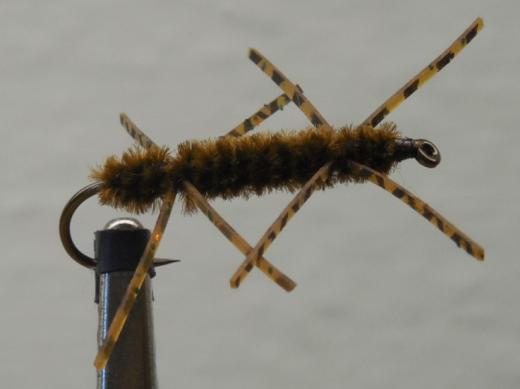The Trout Line Newsletter - November 16, 2020
Fly of the Month - Pat's Rubber Legs
Materials:
Hook: Tiemco 5263, #6, 8, and 10
Thread: Black or brown 8/0
Underbody (weight): Small nontoxic wire
Body: Black or dark brown chenille
Legs: Various dark flat rubber legs
1. Wind and wrap a wire underbody (each wrap tight against the previous wrap) from about 1/8 inch from the start of the hook bend to about 1/4 inch from the back of the eye. Trim the tag ends.
2. Attach the thread just behind the eye, and with a series of spiral wraps over the wire, wind back and forth three or four times from just in front of the wire to just back of the wire. This secures the wire in place and provides a “skin” over the wire so that the other materials will adhere and not force themselves down between the wire wraps. To provide an even transition to the diameter of the wire wraps, add thread windings on the hook shank next to the ends of the wire wraps, to create tapered thread wraps up to the wire. End with the thread bobbin just in back of the back end of the wire.
3. Cut a six inch piece of chenille and tie in the tip at the start of the bend of the hook. Then wind the thread to about ¼ of the way to the eye. I use medium for smaller flies and large for bigger flies.
4. Cut leg segments of about 2/1/2 to 3 inches long (they will be trimmed to length when the fly is finished). Holding a piece horizontal to the hook shank with the middle of the segment at the thread point, tie in a back leg with three thread wraps. The legs will bend outward and roughly horizontal as you wrap them in. Round rubber legs also can be used, but they tend to roll out of horizontal as you wrap them; flat leg material is more forgiving. Repeat on the other side.
5. Wrap the thread to about ¾ of the way to the eye, and tie in front legs on each side. Wrap thread to the back of the eye and leave hanging.
6. Wind the chenille in moderately tight turns to the back legs, then one turn between the legs on each side, then to the front legs (same treatment) and finally to just behind the eye. If needed, you can hold the tag ends of the legs on each side as you make the wraps before, in between and in front, and gently move and hold them back in roughly a horizontal position. Tie off and clip.
7. Wrap a fairly large head, clip and cement.
8. Clip the legs to length – about one inch, but slightly shorter for smaller flies up to slightly longer for larger flies.
TVTU Annual Chapter Members Meeting
The Annual Meeting of Members of the Tualatin Valley Trout Unlimited Chapter took place online in a Zoom meeting on November 11, 2020. Lori Day, Chapter President, gave the chapter update and Michael Gentry gave the Treasurer's report. The elections were then held, first was the re-election of board members. The board members that were re-elected was Andy Andrews, Lori Day, and Bill Schoen. Then two new board members were elected - Alexandria Nguyen-Johnson and David Cosner. Also Peter Gray was elected Vice President and Alexandria Nguyen-Johnson was elected Secretary. After the elections Eric Means, Climate Change Coordinator volunteer for TU in Oregon, did a wonderful presentation about Climate Change.
Welcome New Members
John Von Schlegell - Portland, OR
Scott Nelson - Portland, OR
John Putman - Tillamook, OR
Arthur Erickson - Portland, OR
Ron Maben - Portland, OR
Douglas Trout - Banks, OR
Peter Hollomon - Beaverton, OR
Robert Murfitt - Portland, OR
Jonathon Tuck - Portland, OR
Craig Dent - McMinnville, OR
Andrew Smith - Portland, OR
Greg Goodman - Portland, OR
Joe O'Kelley - Hillsboro, OR
Rube S. Salmonberry - Tigard, OR
Julius Samson - Beaverton, OR
Andrew Marble - Saint Helens, OR
Michelle Partin - Carlton, OR
Melissa Wilmot - Portland, OR
Don Rosen - Beaverton, OR
Robert Buscher - Sheridan, OR
Ken Vandomelen - Portland, OR
Dr. David McAllister - Portland, OR
Randal Fulgham - Portland, OR
Don Kildal - King City, OR
David Putman - Tualatin, OR
Julie Marshall - Yamhill, OR
Larry Misevicius - Portland, OR
Chris Culligan - Hillsboro, OR
Meetings Location and Dates
Regular chapter meetings are held at the Lucky Labrador Public House 7675 SW Capitol Hwy. Portland, OR 97219 (503) 244-2537. Food and beverage are available. Social get together starts at 6:30 pm and the formal meeting starts at 7:00 pm unless otherwise noted in the newsletter or website.
December Meeting - TBD
More Information:
TVTU Website: https://tualatinvalley.tu.org/
TVTU Facebook Page: https://www.facebook.com/tualatinvalleyTU/
C4C Facebook Page: https://www.facebook.com/christmasforcoho/


